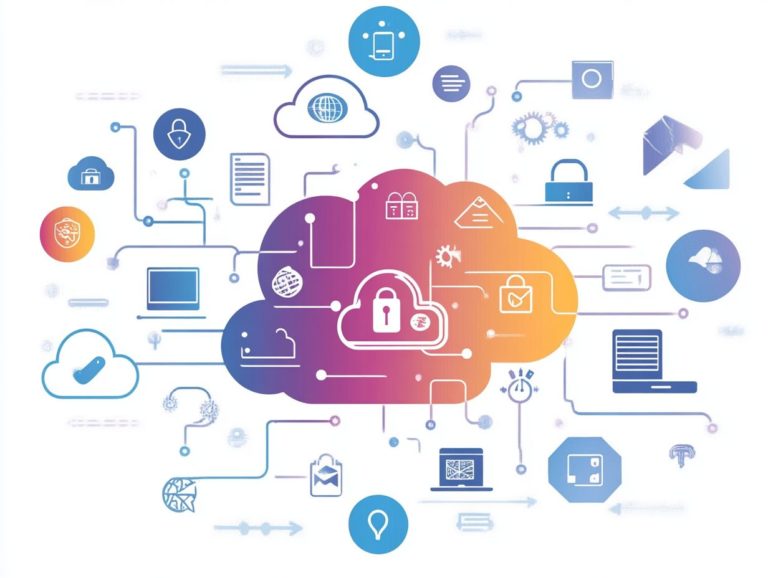How to Mitigate DDoS Attacks in the Cloud
DDoS attacks are a serious threat to cloud services. They can lead to disruptions that inflict severe financial and reputational harm.
This article explores the details of DDoS attacks, covering everything from their definition to the various types that exist. It also examines the impact these attacks have on cloud services and offers best practices for mitigating the associated risks.
In today s digital landscape, it s crucial to know how to prepare for and respond to these attacks. You re invited to explore the future of DDoS mitigation strategies in the cloud with us.
Contents
Key Takeaways:

Implement strong network security measures to prevent DDoS attacks in the cloud.
Utilize DDoS protection services to mitigate the impact of attacks and protect against financial and reputational damage.
Create a comprehensive incident response plan and regularly test and monitor for potential DDoS attacks in the cloud.
Understanding DDoS Attacks
Grasping the nuances of DDoS attacks is essential for any organization striving to uphold the integrity and availability of its cloud services.
These Distributed Denial of Service (DDoS) attacks unleash a torrent of traffic from countless sources. This effectively derails normal operations and presents substantial security risks especially for businesses that depend on cloud infrastructures like AWS, Azure, and Google Cloud.
You can leverage advanced detection and mitigation techniques offered by service providers. This serves as a formidable line of defense against these malicious incursions and underscores the critical importance of strategic preparation and robust response capabilities in today’s complex digital landscape.
What is a DDoS Attack?
A DDoS attack represents a deliberate effort to disrupt the normal operation of a targeted server, service, or network by overwhelming it with an excessive surge of Internet traffic.
These attacks are typically orchestrated using compromised systems, often referred to as ‘bots’ or ‘zombies’ computers controlled by attackers. The aim is usually to render a website or service inaccessible, leading to significant inconvenience and potential financial repercussions.
The malicious traffic can vary from simple HTTP requests to more intricate protocols, all meticulously crafted to exploit vulnerabilities within the target s architecture. Common methods employed include:
- UDP floods
- SYN floods
- Amplification attacks
Each of these techniques capitalizes on specific weaknesses within network protocols and application layers to fulfill their disruptive objectives.
Types of DDoS Attacks
DDoS attacks take on many forms, employing distinct methods to inundate a target. From HTTP floods to DNS queries, SYN floods to SSL abuse, these attacks can severely disrupt both application-layer and network-layer processes.
For anyone responsible for managing cloud services, understanding how these strategies work is essential. HTTP floods bombard web applications with an overwhelming number of requests, causing them to slow down or become entirely unresponsive.
In contrast, DNS query attacks jeopardize domain name systems, cutting off access to hosted services. SYN floods exploit the TCP connection process, paralyzing servers and preventing them from handling legitimate requests. Concurrently, SSL abuse overwhelms secure server connections, undermining effective communication.
Being aware of these attack vectors helps in crafting robust security measures and devising swift response plans in case of an attack. This proactive approach ultimately protects user trust and ensures service availability.
Impact of DDoS Attacks on Cloud Services
DDoS attacks can profoundly disrupt cloud services, significantly affecting both operational performance and overall service availability.
If your organization relies on cloud infrastructures such as AWS, Azure, or Google Cloud, you could face financial losses due to downtime, along with reputational damage that might deter potential customers.
DDoS attacks can cause immediate and severe consequences, highlighting the urgent need for robust security measures. By implementing effective strategies to prevent and respond to incidents, you can ensure your business maintains continuous service delivery, even when confronted with these formidable threats.
Disruption of Services

DDoS attacks can severely disrupt services. They present operational challenges that affect both cloud services and the users who rely on them.
In 2020, a major cloud provider experienced a massive DDoS attack, overwhelming its network. This led to long outages that blocked access to critical applications for many businesses.
Such attacks show how one event can disrupt interconnected systems, crippling workflows and frustrating users. It’s vital for your organization to take preventive steps with strong security controls.
Creating a solid incident response plan can reduce downtime and speed recovery. This minimizes productivity loss and helps maintain user trust.
Financial and Reputational Damage
The financial impact of DDoS attacks can be shocking. Your organization could lose millions in revenue from service outages and unhappy customers.
Beyond immediate losses, recovery costs for system restoration and enhanced security can strain your finances. Protecting customer data is crucial; failure to do so may result in hefty fines.
When customers feel their data is insecure, they may take their business elsewhere. This can damage loyalty and future sales.
By adopting strong security measures, you not only protect your organization but also show customers you care about their interests and your reputation.
Best Practices for Mitigating DDoS Attacks in the Cloud
To effectively combat DDoS attacks, you must implement solid network security best practices. This protects your cloud infrastructure while ensuring service availability.
A mix of tailored protection strategies will boost your resilience against evolving threats. Integrating DDoS protection services into your security framework prepares you to handle potential attacks confidently.
Implementing Strong Network Security
Strong network security is your first line of defense against DDoS attacks. Establish robust access controls and manage resources effectively to protect valuable data.
This strategy creates a resilient framework that deters attacks and ensures smooth operations during peak traffic. Access controls, like role-based access and identity management, help ensure only authorized users access sensitive data.
Efficient resource management, including load balancing and traffic prioritization, is crucial for service availability. Implementing firewalls and intrusion detection systems boosts your defenses.
Conduct regular security audits and provide comprehensive employee training. Tools like AWS Shield or Cloudflare will further strengthen your network security posture.
Utilizing DDoS Protection Services
Utilizing Distributed Denial of Service (DDoS) protection services from reputable cloud service providers is essential for organizations like yours that want to safeguard their infrastructure from potential threats.
With robust traffic analysis and monitoring, these services significantly enhance your incident support. They often include advanced features such as real-time traffic inspection, which allows you to quickly identify malicious patterns and anomalies.
This capability enables you to take swift action to mitigate attacks before they escalate. Many of these services integrate seamlessly with your existing security architecture, strengthening your defenses without requiring an overhaul of your current systems.
These services are vital for your incident response strategy, offering automated alerts and valuable insights. This helps your team react swiftly to security incidents, minimizing downtime and protecting your essential online resources from disruption.
Preparing for and Responding to DDoS Attacks

You must prepare and respond quickly to DDoS attacks to keep your services running smoothly. Developing comprehensive incident response plans that are well-communicated and regularly practiced is crucial.
This preparation involves implementing robust threat detection strategies and integrating security analysts into response teams. This ensures that everyone understands their roles when an attack occurs.
By taking these proactive steps, you can significantly boost your organization s resilience against such threats.
Creating an Incident Response Plan
Creating an effective incident response plan for DDoS attacks is crucial for swiftly reacting to and mitigating the impact of an attack, minimizing service disruptions.
By defining clear roles and responsibilities within your team, you enable key personnel to take decisive actions during an incident. Establishing robust communication protocols ensures that information flows seamlessly among all stakeholders, facilitating efficient coordination of responses.
Implementing a structured post-incident analysis allows you to learn from each event, refine your tactics, and enhance your preparedness. Best practices recommend regularly reviewing and updating your plan to align with emerging threats and vulnerabilities.
This guarantees that your organization s defenses remain adaptive and resilient in an ever-evolving digital landscape.
Testing and Monitoring for DDoS Attacks
Regular testing and monitoring for potential DDoS attacks is crucial for maintaining robust security and ensuring the performance and availability of your cloud services.
You can use various testing methods to thoroughly assess your vulnerability levels. Techniques like simulations provide a controlled environment to see how your systems respond in attack scenarios.
Stress tests push your infrastructure to its limits, revealing any potential weaknesses. Continuous monitoring is essential; it allows you to identify anomalies that could indicate an impending threat, enabling a swift response.
By adopting a proactive approach, you not only safeguard your operations but also enhance your overall resilience against evolving cyber threats.
Future of DDoS Mitigation in the Cloud
The future of DDoS mitigation in the cloud is being transformed by emerging technologies and advanced methodologies. These innovations harness the power of artificial intelligence and behavioral analytics to improve threat detection and response capabilities.
As cyber attacks grow more sophisticated, your need for innovative, custom solutions designed to adapt to these evolving threats has never been more pressing. This evolution promises enhanced scalability and flexibility in security measures across your cloud services, ensuring that your defenses remain strong in an ever-changing landscape.
Emerging Technologies and Strategies
Emerging technologies play a crucial role in transforming DDoS mitigation strategies, especially within cloud services. The integration of artificial intelligence and behavioral analytics enables proactive identification and neutralization of threats.
These advancements boost the speed and accuracy of threat detection and allow for a more adaptive response to various attack vectors. For instance, machine learning algorithms analyze vast amounts of network traffic in real time, making it easier to spot anomalies that may signal a potential attack.
Cloud service providers are increasingly adopting decentralized architectures, which help distribute resources and customer data more securely. This further reduces the impact of DDoS assaults.
By leveraging these technologies, you can significantly enhance your security framework, ensuring greater resilience against sophisticated cyber threats.
Frequently Asked Questions

1. Understanding DDoS Attacks
A DDoS (Distributed Denial of Service) attack overwhelms a network or server with excessive traffic, making it inaccessible to legitimate users. In cloud systems, DDoS attacks can disrupt the availability and performance of hosted applications and services, causing significant financial and reputational damage.
2. Identifying a DDoS Attack
Signs of a DDoS attack on your cloud system include unusually slow network or application performance, an increase in spam or phishing emails, and unexplained spikes in network traffic. Regularly monitoring your cloud system is crucial for your security!
3. Common Mitigation Methods
To mitigate DDoS attacks in the cloud, consider using a web application firewall (WAF) to filter out malicious traffic. Implement network-level protections, such as rate limiting and blacklisting, and utilize cloud-based DDoS protection services. Combining these methods offers a comprehensive defense.
4. Proactively Preventing DDoS Attacks
Regularly updating and patching your software and applications is critical, as attackers exploit vulnerabilities to launch DDoS attacks. Implementing strong network and access controls, like multi-factor authentication and strict permission settings, can further help prevent unauthorized access and potential DDoS attacks.
5. Using Cloud Services During an Attack
Yes, you can still use cloud services while mitigating a DDoS attack. However, depending on the attack’s severity, there may be performance disruptions. Having a DDoS response plan is essential to minimize the impact on your operations.
6. Steps After a DDoS Attack
After a DDoS attack, conducting a thorough investigation is vital to determine the cause and extent of the attack. This helps prevent future incidents and identifies vulnerabilities in your system. Reviewing and updating your DDoS mitigation plan is also recommended to address any gaps exposed during the attack.
In conclusion, ensuring strong DDoS protection is essential for the integrity and availability of your cloud systems. Have you checked your DDoS protection today?






